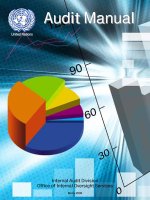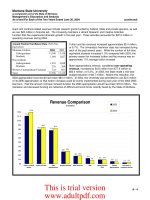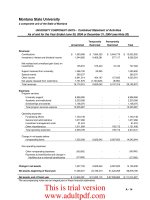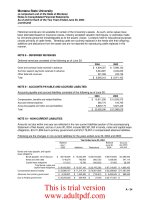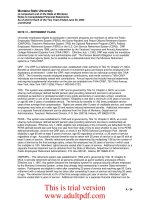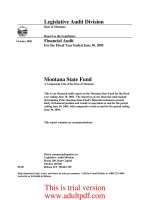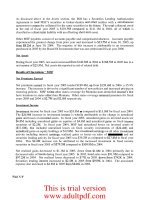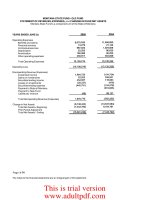Audit Manual Internal Audit Division Office of Internal Oversight Services docx
Bạn đang xem bản rút gọn của tài liệu. Xem và tải ngay bản đầy đủ của tài liệu tại đây (3.29 MB, 185 trang )
United Nations
United Nations
United Nations
Audit Manual
Audit Manual
Internal Audit Division
Office of Internal Oversight Services
MARCH 2009
AUDIT MANUAL
Internal Audit Division, Office of Internal Oversight Services
Preface to the March 2009 edition
This edition of the Internal Audit Manual reflects the recent changes made by the
Institute of Internal Auditors to the International Standards for the Professional
Practice of Internal Auditing. Related sections of the Manual have also been
revised based on the changes to the Standards.
Fatoumata Ndiaye, Acting Director
Internal Audit Division, OIOS
New York, March 2009
Preface to the August 2008 edition
The Internal Audit Division (IAD or the Division) is one of three divisions of the
Office of Internal Oversight Services (OIOS) providing internal oversight services to
the United Nations. The Internal Audit Manual (Manual) sets out the policies and
procedures that govern the conduct of internal auditing at the United Nations. It
describes the underlying principles, standards and code of ethics for the
professional practice of internal auditing, and describes the Division’s audit
management process from planning and preparation to the performance of the
audit, reporting of results and follow-up of recommendations.
The Manual incorporates the Attribute and Performance Standards of the
International Standards for the Professional Practice of Internal Auditing
(Standards) developed and maintained by the Institute of Internal Auditors (IIA).
The IIA Standards were adopted as mandatory guidance for the practice of
internal auditing in the United Nations following the 33
rd
annual meeting of the
Representatives of Internal Audit Services of United Nations Organizations and
Multilateral Financial Institutions, in June 2002. Each chapter of the Manual
cites the applicable IIA Standards and sets out the policies, procedures and
practices applied by IAD in conformity therewith.
All IAD policies and procedures should be complied with. Inability to comply with
any of them should be brought to the attention of the IAD management
immediately.
The purpose of the Audit Manual is to:
AUDIT MANUAL
Internal Audit Division, Office of Internal Oversight Services
a. Provide guidance on all relevant aspects of the audit function, including
standards and procedures to be followed and adhered to;
b. Promote the highest level of professional competence in IAD; and
c. Provide a basis for measuring audit performance.
The Manual is not designed to be all-inclusive or unduly restrictive. Its provisions
and procedures are intended to supplement the experience, competencies, skills,
and judgement of auditors in planning, conducting and reporting on audits. The
Audit Manual is meant to assist IAD staff in effectively performing their auditing
duties and to serve as a “user-friendly toolbox” for auditors, offering standardized
templates, checklists and forms, as well as more detailed guidance on certain
steps of the audit process.
The Manual and its appendices are living documents and will be continuously
updated, amended and enhanced. Experience gained from actual usage will
certainly lead to a number of changes. The Manual is the result of a team effort,
and I wish to express my appreciation to those IAD staff members who have
contributed their time and effort to its successful completion.
Dagfinn Knutsen, Director
Internal Audit Division, OIOS
New York, August 2008
AUDIT MANUAL
Internal Audit Division, Office of Internal Oversight Services
Contents
Acronyms used in the Manual
A United Nations internal audit function 1 – 10
A.1 Introduction 1
A.2 Definition of internal auditing 1
A.3 Relevant legislative and oversight bodies 2
A.3.1 Independent Audit Advisory Committee 2
A.3.2 UNHCR Internal Oversight Committee 3
A.3.3 Audit Committee of the United Nations Joint Staff Pension Fund 3
A.3.4 Other oversight committees 3
A.4 Mandate 3
A.4.1 Internal Audit Charter 6
A.5 Organization structure 6
A.6 Services provided by the Internal Audit Division 7
A.6.1 Audit services 7
A.6.2 Advisory services 9
B Internal audit policies 11 – 39
B.1 Code of conduct and professional guidance 11
B.1.1 IAD’s Code of Professional and Ethical Conduct 11
B.1.2 The International Professional Practices Framework 13
B.1.3 Code of Ethics 14
B.2 Professional responsibilities 16
B.2.1 Independence and objectivity 16
B.2.2 Organizational independence 17
B.2.3 Individual independence and objectivity 18
B.3 Proficiency and due professional care 19
B.3.1 Proficiency 21
B.3.2 Due professional care 24
AUDIT MANUAL
Internal Audit Division, Office of Internal Oversight Services
B.3.3 Continuing professional development 25
B.4 Quality assurance and improvement programme 26
B.4.1 Internal assessments 28
B.4.2 External assessments 29
B.4.3 Statement of conformance 29
B.5 Managing the Internal Audit Division 30
B.5.1 Planning 30
B.5.2 Communication and approval 31
B.5.3 Resource management 31
B.5.4 Coordination 32
B.5.5 Reporting to the General Assembly and the Secretary-General 34
B.6 Risk assessment 34
B.7 Internal control 37
B.7.1 Objectives of internal control 38
B.7.2 Components of internal control 38
C Internal audit procedures 40 119
C.1 Preparation of IAD work plan 40
C.1.1 Sources of assignments 42
C.1.2 Review and approval of the work plan 43
C.1.3 Changes to the approved work plan 45
C.2 Overview of the audit process 45
C.2.1 Audit phases 45
C.2.2 Roles and responsibilities of audit personnel 46
C.2.3 Audit documentation 48
C.3 Engagement planning 49
C.3.1 Introduction 49
C.3.2 Selecting the assignment 52
C.3.3 Assigning the Auditor-in-Charge and audit staff 52
C.3.4 Audit notification memorandum 53
AUDIT MANUAL
Internal Audit Division, Office of Internal Oversight Services
C.3.5 Entry conference 53
C.3.6 Conducting the audit planning activities 56
C.3.7 Developing the audit plan and audit programme 65
C.4 Audit fieldwork 70
C.4.1 Introduction 70
C.4.2 Orienting the audit team and assigning team member
responsibilities
71
C.4.3 Executing the audit programme 72
C.4.4 Supervising the audit 82
C.4.5 Communicating with IAD management during fieldwork 84
C.4.6 Communicating with the audited entity during fieldwork 85
C.4.7 Exit conference 85
C.5 Reporting audit results and audit closure 87
C.5.1 Introduction 87
C.5.2 Types and structure of audit reports 90
C.5.3 Contents of audit reports 91
C.5.4 Draft audit reports 98
C.5.5 Final audit reports 102
C.5.6 Audit closing memorandum 105
C.5.7 Release of audit reports to Member States 106
C.5.8 Report processing and issuance timelines 107
C.5.9 General Assembly reports 108
C.5.10 Updating the recommendations database, Issue Track 109
C.5.11 Staff appraisal 112
C.5.12 Audit closure 113
C.6 Audit monitoring 114
C.6.1 Monitoring implementation of audit recommendations 114
C.6.2 Resolving non-implemented recommendations 117
C.6.3 Client satisfaction survey 118
C.6.4 Annual Report and Semi-annual Report 119
AUDIT MANUAL
Internal Audit Division, Office of Internal Oversight Services
D Administration 120 129
D.1 Administration of assignments 120
D.1.1 Time recording 120
D.1.2 Controlling assignments 121
D.2 Working papers 123
D.2.1 Ownership of and access to working papers 124
D.2.2 Retention of working papers 124
D.2.3 Confidentiality 124
D.3 Handover of duties 125
D.4 Communication 126
D.4.1 Communication with other OIOS Divisions 126
D.4.2 Communication with Board of Auditors and other oversight bodies 126
D.4.3 General correspondence and e-mail standards 126
E Annexes 130 – 145
E.1 OIOS organization chart 130
E.2 IAD organization structure 131
E.3 IAD organization chart 132
E.4 List of templates 133
E.5 Organization of an AutoAudit working paper file 134
E.6 Job descriptions 136
E.6.1 Director – D-2 136
E.6.2 Deputy Director – D-1 137
E.6.3 Service Chief – D-1 137
E.6.4 Section Chief – P-4/P-5 139
E.6.5 Chief Resident Auditor – P-4/P-5 140
E.6.6 Auditor – P-4 141
E.6.7 Auditor – P-3 142
E.6.8 Associate Auditor – P-2 143
E.6.9 Audit Assistant – G-7 143
E.6.10 Audit Assistant – G-6 144
AUDIT MANUAL
Internal Audit Division, Office of Internal Oversight Services
E.6.11 Audit Assistant – G-5 145
F Flowchart of audit management process 146 175
F.1 Flowcharting symbols 146
F.2 Audit engagement planning 147
F.2.1 Selecting the audit assignment 147
F.2.2 Assigning the Auditor-in-Charge and audit staff 148
F.2.3 Audit notification memorandum 149
F.2.4 Entry conference 150
F.2.5 Conducting the planning activities 151
F.2.6 Developing the audit plan and programme 152
F.3 Audit fieldwork 154
F.3.1 Assigning responsibilities, executing the audit programme and
reviewing working papers
154
F.3.2 Communication with IAD management during fieldwork 157
F.3.3 Exit conference 159
F.4 Reporting audit results and audit closure 161
F.4.1 Draft audit report 161
F.4.2 Final audit report 164
F.4.3 Updating Issue Track 168
F.4.4 Staff appraisal 169
F.4.5 Audit closure 170
F.5 Audit monitoring 171
F.5.1 Client satisfaction survey 171
F.5.2 Monitoring implementation of recommendations 172
F.5.3 Resolving non-implemented recommendations 173
F.5.4 Annual Report and Semi-annual Report 175
AUDIT MANUAL
Internal Audit Division, Office of Internal Oversight Services
Acronyms used in the manual
Acronym Term
IAD Internal Audit Division
OIOS Office of Internal Oversight Services
UN United Nations
ACABQ Advisory Committee on Administrative and Budgetary Questions
AIC Auditor-in-Charge
AR Annual Report
ASAR Audit Staff Appraisal Record
BOA United Nations Board of Auditors
CAATs Computer-Assisted Audit Techniques
COSO Committee of Sponsoring Organizations of the Treadway Commission
CRA Chief Resident Auditor
DGACM Department for General Assembly and Conference Management
GA General Assembly
IAAC Independent Audit Advisory Committee
ICT Information and Communications Technology
ID Investigations Division
IED Inspection and Evaluation Division
IIA The Institute of Internal Auditors
IMDIS Integrated Monitoring and Documentation Information System
IMIS Integrated Management Information System
IT Information Technology
JIU Joint Inspection Unit
OUSG Office of the Under-Secretary General, OIOS
PAS United Nations Performance Appraisal System
PPS Professional Practices Section
RCS Recommendations Coding Sheet
RCW Record of Control Weaknesses
SAR Semi-annual Report
Standards International Standards for the Professional Practice of Internal Auditing
USG/OIOS Under-Secretary-General for Internal Oversight Services
UNHCR United Nations High Commissioner for Refugees
UNJSPF United Nations Joint Staff Pension Fund
AUDIT MANUAL
Internal Audit Division, Office of Internal Oversight Services
1
A United Nations internal audit function
A.1 Introduction
Responsibility for internal auditing in the United Nations is assigned to the Office
of Internal Oversight Services (OIOS). By its resolution 48/218 B
of 29 July 1994,
the General Assembly authorized the establishment of OIOS and, with respect to
internal audit, decided that:
“The Office shall, in accordance with the relevant provisions of the
Financial Regulations and Rules of the United Nations examine, review
and appraise the use of financial resources of the United Nations in
order to guarantee the implementation of programmes and legislative
mandates, ascertain compliance of programme managers with the
financial and administrative regulations and rules, as well as with the
approved recommendations of external oversight bodies, undertake
management audits, reviews and surveys to improve the structure of
the Organization and its responsiveness to the requirements of
programmes and legislative mandates, and monitor the effectiveness
of the systems of internal control of the Organization”.
The Internal Audit Division (IAD or the Division) of OIOS bears primary
responsibility for audits. IAD conducts audits in accordance with the International
Standards for the Professional Practice of Internal Auditing (Standards).
A.2 Definition of internal auditing
The Institute of Internal Auditors provides the following definition of internal
auditing:
Internal auditing is an independent, objective assurance and consulting activity
designed to add value and improve an organization's operations. It helps an
organization accomplish its objectives by bringing a systematic, disciplined
approach to evaluate and improve the effectiveness of risk management,
control, and governance processes.
AUDIT MANUAL
Internal Audit Division, Office of Internal Oversight Services
2
A.3 Relevant legislative and oversight bodies
The General Assembly is the governing body of the United Nations. The Fifth
Committee (Administrative and Budgetary) is the main committee of the General
Assembly entrusted with responsibilities for administration and budgetary
matters. It is assisted by the Advisory Committee on Administrative and
Budgetary Questions (ACABQ). Both bodies play a significant role in oversight at
the United Nations, and IAD reports are discussed by both the Fifth Committee
and the ACABQ. Oversight is further strengthened by the establishment of the
following committees.
A.3.1 Independent Audit Advisory Committee
The General Assembly, in section 13(4) of resolution 60/248 of 23 December
2005, decided to establish an Independent Audit Advisory Committee (IAAC) to
serve in an expert advisory capacity to assist the General Assembly in discharging
its oversight function. The specific terms of reference of the IAAC were adopted
by the Assembly in a subsequent resolution 61/275 of 29 June 2007. The IAAC is
comprised of five members serving a term of three years, with an option to renew
for a second and final term of three years. The tasks of the IAAC as they relate to
internal oversight are:
a. “To examine the work plan of the Office of Internal Oversight Services,
taking into account the work plan of the other oversight bodies, with
the Under-Secretary-General for Internal Oversight Services and to
advise the Assembly thereon;
b. “To review the budget proposal of the Office of Internal Oversight
Services, taking into account its work plan, and to make
recommendations to the Assembly through the Advisory Committee on
Administrative and Budgetary Questions; the formal report of the
Independent Audit Advisory Committee should be made available to
the Assembly and to the Advisory Committee on Administrative and
Budgetary Questions prior to their consideration of the budget; and
c. “To advise the Assembly on the effectiveness, efficiency and impact of
the audit activities and other oversight functions of the Office of
Internal Oversight Services.”
The IAAC became operational in January 2008.
AUDIT MANUAL
Internal Audit Division, Office of Internal Oversight Services
3
A.3.2 UNHCR Internal Oversight Committee
An Internal Oversight Committee was established by the High Commissioner of
the United Nations High Commissioner for Refugees (UNHCR), by IOM/10/97-
FOM/14/97 of 6 February 1997. The terms of reference of the Committee were
revised by IOM/59/04-FOM/61/04 on 28 September 2004. The purpose of the
Committee is to assist the High Commissioner in overseeing the financial and
operational management of the agency, to monitor the independence and
effectiveness of the internal oversight functions (audit, inspection and
investigation) and to ensure that oversight findings and recommendations are
adequately addressed. The Committee coordinates the activities of all oversight
services within UNHCR with a view to optimising their complementarities and
cooperation, monitoring the status of implementation of oversight
recommendations and, as necessary, taking steps to ensure their adequate
implementation. UNHCR is revisiting the terms of reference of its Internal
Oversight Committee to align them with best practices taking into consideration
the terms of reference of the IAAC.
A.3.3 Audit Committee of the United Nations Joint Staff Pension Fund
The United Nations Joint Staff Pension Fund (UNJSPF) has established an audit
committee to, inter alia, provide general oversight and offer recommendations for
the Fund’s audit arrangements, oversee the work of internal auditors and
consider the scope, results and effectiveness of audit reports.
A.3.4 Other oversight committees
Various other IAD audited entities have or are in the process of establishing their
own audit/oversight committees. For example, the International Trade Centre has
established an Oversight Committee “to ensure that effective monitoring tools are
strengthened and that responsibility is assigned at the highest level of the
management structure for implementation and follow-up of the recommendations
of oversight bodies” (EDB/2006/2 of 9 June 2006).
A.4 Mandate
Applicable IIA Standard
1000 – Purpose, Authority, and Responsibility
The purpose, authority, and responsibility of the internal audit activity must be
formally defined in an internal audit charter, consistent with the Definition of
AUDIT MANUAL
Internal Audit Division, Office of Internal Oversight Services
4
Internal Auditing, the Code of Ethics, and the Standards. The chief audit
executive must periodically review the internal audit charter and present it to
senior management and the board for approval.
1000.A1 – The nature of assurance services provided to the organization
must be defined in the internal audit charter. If assurances are to be
provided to parties outside the organization, the nature of these assurances
must also be defined in the internal audit charter.
1000.C1 – The nature of consulting services must be defined in the internal
audit charter.
1010 – Recognition of the Definition of Internal Auditing, the Code of Ethics,
and the Standards in the Internal Audit Charter
The mandatory nature of the Definition of Internal Auditing, the Code of Ethics,
and the Standards must be recognized in the internal audit charter. The chief
audit executive should discuss the Definition of Internal Auditing, the Code of
Ethics, and the Standards with senior management and the board.
OIOS was formally established with the promulgation of the Secretary-General’s
Bulletin ST/SGB/273 of 7 September 1994, which provided that:
a. The responsibilities of OIOS shall extend to the resources and staff of the
Organization, including separately administered organs;
b. OIOS has the authority to initiate, carry out and report on any action which it
considers necessary to fulfill its responsibilities in regard to the audit function;
c. OIOS shall discharge its responsibilities without any hindrance and need for
prior clearance, and shall have the right to direct and prompt access to all
staff, records, documents and premises of the Organization and to obtain all
necessary information and explanations; and
d. OIOS shall conduct ad hoc audits of programmes and organizational units
whenever there are reasons to believe that programme oversight is not
sufficiently effective and that there is potential for the non-attainment of
objectives and waste of resources, and otherwise as the Under-Secretary-
General for Internal Oversight Services deems appropriate, with a view to
recommending to management corrective measures.
In 1999 and in 2004, the Fifth Committee of the General Assembly reviewed the
functions and reporting procedures of OIOS. As a result of these reviews, General
Assembly resolution 54/244 of 23 December 1999 set out a number of
provisions on OIOS for funds and programmes, functions, coordination,
AUDIT MANUAL
Internal Audit Division, Office of Internal Oversight Services
5
investigations, reporting, and operational independence. The General Assembly
resolution 59/272
dated 23 December 2004 provided that reports of OIOS shall
be submitted directly to the General Assembly as prepared by the Office, and that
the comments of the Secretary-General may be submitted in a separate report.
The same resolution further provided that original versions of OIOS reports that
are not submitted to the General Assembly, should be made available to any
Member State upon request. The resolution also requested the Secretary-
General to establish mechanisms to effectively feed the findings and
recommendations of OIOS, as well as relevant findings of the Joint Inspection Unit
and the Board of Auditors, into the executive management processes. To achieve
this, the Secretary General established the Management Committee with the
responsibility to inter alia, “ensure that findings and recommendations of the
Board of Auditors, the Joint Inspection Unit and the Office of Internal Oversight
Services are effectively fed into the executive management processes, and that
accepted recommendations are followed up and implemented in a timely
manner” (ST/SGB/2005/13
and ST/SGB/2006/14).
OIOS provides worldwide internal auditing, investigation, monitoring, inspection
and evaluation services to all UN activities under the Secretary-General's
authority including:
a. The United Nations Secretariat in New York, Geneva, Nairobi, and Vienna
b. The five regional commissions: Economic Commission for Africa; Economic
Commission for Europe; Economic Commission for Latin America and the
Caribbean; Economic and Social Commission for Asia and the Pacific and
Economic and Social Commission for West Asia.
c. Peacekeeping missions in various parts of the world
d. International Criminal Tribunal for the former Yugoslavia and the International
Criminal Tribunal for Rwanda
e. The International Court of Justice
f. United Nations Research and Training Institutes
g. Funds and Programmes administered separately under the authority of the
Secretary-General, which have requested OIOS audit services (such as Office
of the High Commissioner for Human Rights, United Nations on Drug and
Crime, UNHCR, United Nations Conference on Trade and Development,
International Trade Centre, United Nations Environment Programme and
United Nations Human Settlements Programme).
AUDIT MANUAL
Internal Audit Division, Office of Internal Oversight Services
6
h. Other entities related to the United Nations, which have requested OIOS audit
services (such as UNJSPF, United Nations Framework Convention on Climate
Change and United Nations Convention to Combat Desertification).
A.4.1 Internal Audit Charter
IAD’s internal audit charter is being developed and will be published separately.
A.5 Organization structure
The organization of OIOS is promulgated by the Secretary-General’s bulletin
ST/SGB/2002/7 of 16 May 2002, titled “Organization of the Office of Internal
Oversight Services”. While this bulletin is still in force, changes to the structure
have since been made under the authority of the Under-Secretary-General for
Internal Oversight Services (USG/OIOS) and the revised chart is shown in Annex
E.1.
OIOS is headed by an Under-Secretary-General who reports directly to the
Secretary-General and is comprised, under the current structure, of the following:
a. Office of the Under-Secretary General (OUSG)
b. Executive Office
c. Internal Audit Division (IAD)
d. Investigations Division (ID)
e. Inspection and Evaluation Division (IED)
The USG/OIOS advises the Secretary-General and senior management of the
Organization on oversight issues; represents OIOS before the legislative organs
and their subsidiary bodies; oversees the implementation of the internal strategic
organizational plans and goals; ensures cooperation and synergies between the
different internal oversight functions, including joint reviews when appropriate;
oversees the preparation of the Strategic Framework and biennial budgets of the
Office; and ensures coordination of the Office’s work programme with the
activities of the United Nations Board of Auditors (BOA) and the Joint Inspection
Unit (JIU).
AUDIT MANUAL
Internal Audit Division, Office of Internal Oversight Services
7
IAD consists of its Headquarters in New York, and Audit Services based at the
United Nations Offices in New York, Geneva and Nairobi as well as the
Peacekeeping Audit Service. See Annexes E.2
and E.3 for IAD organization
structure and chart.
A.6 Services provided by the Internal Audit Division
In accordance with the Standards, internal audit may provide both assurance and
consulting services. The Standards define these services as follows:
a. Assurance services - An objective examination of evidence for the purpose of
providing an independent assessment on risk management, control, or
governance processes of the Organization. Examples may include financial,
performance, compliance, system security, and due diligence engagements.
b. Consulting services – Advisory and related client service activities, the nature
and scope of which are agreed upon with the client and which are intended to
add value and improve an organization’s operations. Examples include
counsel, advice, facilitation, process design, and training.
In this Manual, Assurance services are referred to as ‘Audit services’ while the
term ‘Advisory services’ is used for consulting activities.
IAD auditors may provide audit and advisory services as part of their normal,
routine activities or in response to specific requests from management of the
audited entity.
A.6.1 Audit services
Audit services involve the internal auditor’s objective assessment of evidence to
provide an independent opinion or conclusions regarding a process, system, or
other subject matter. Audits should be conducted in accordance with the IIA
Standards.
In the United Nations context, audits are specifically mandated in the relevant
provisions of the Financial Regulations and Rules of the United Nations.
Regulation 5.15 of ST/SGB/2003/7 (Financial Regulations and Rules of the
United Nations) states that OIOS:
“shall conduct independent internal audits in accordance with
regulation 5.8 (d) and in conformity with generally accepted auditing
standards. Internal auditors shall review, evaluate and report on the
AUDIT MANUAL
Internal Audit Division, Office of Internal Oversight Services
8
use of financial resources and on the effectiveness, adequacy and
application of internal financial control systems, procedures and other
relevant internal controls. Internal audits shall also include the
following elements:
a. Compliance of financial transactions with General Assembly
resolutions, approved programmes and other legislative mandates,
with regulations and rules and related administrative instructions
and with the approved recommendations of external oversight
bodies; and
b. Economy, efficiency and effectiveness of financial, physical and
human resources management and utilization and of programme
delivery, including by examining the structure of the Organization
and its responsiveness to the requirements of programmes and
legislative mandates and by conducting management audits.”
Regulation 5.8 (d) states that:
“the Secretary-General shall … maintain internal financial control,
which shall provide for an effective current examination and/or review
of financial transactions in order to ensure:
a. The regularity of the receipt, custody and disposal of all funds and
other financial resources of the Organization;
b. The conformity of obligations and expenditures with the
appropriations or other financial provisions voted by the General
Assembly or with the purposes and rules relating to trust funds and
special accounts; and
c. The effective, efficient and economic use of the resources of the
Organization.”
Further, and as pertaining to audit services provided to UNHCR, the Financial
Rules for Voluntary Funds Administered by the High Commissioner for Refugees
(A/AC.96/503/Rev.7
of 7 October 1999) stipulate in Article 12 – Audit:
“that all financial transactions and related activities covered by these
rules shall be subject to audit by the UNHCR Audit Service of the Office
of Internal Oversight Services.”
AUDIT MANUAL
Internal Audit Division, Office of Internal Oversight Services
9
In this regard, OIOS provides internal audit services to UNHCR under a Letter of
Agreement on the Provision of Audit Services between OIOS and UNHCR
concluded on 23 March 2007.
The authority for OIOS to audit the financial transactions and related activities of
audited entities with extra-budgetary funding is given in their respective financial
regulations and rules.
IAD fulfils its audit obligations by:
a. Conducting financial, performance, compliance and information systems
audits of all United Nations activities under the administrative responsibility of
the Secretary-General;
b. Providing internal audit services as requested by separately administered
funds and programmes;
c. Conducting audits of programme output delivery as provided for in rule 106.1
(c) of the Regulations and Rules Governing Programme Planning, the
Programme Aspects of the Budget, the Monitoring of Implementation, and the
Methods of Evaluation (ST/SGB/2000/8);
d. Assessing the effectiveness of internal control systems;
e. Recommending measures to strengthen internal control, to ensure: (i)
compliance with legislative mandates, and UN regulations, rules and
contracts; (ii) reliability and integrity of financial and operational information;
(iii) safeguarding of resources against loss, misuse and damage due to waste,
abuse, mismanagement, errors, and fraud; and (iv) efficiency and
effectiveness of operations; and
f. Monitoring the implementation of audit recommendations and reporting on
the status thereof.
A.6.2 Advisory services
Internal auditors generally provide advisory services at the specific request of an
audited entity, but as auditors, they do not have the management authority or
responsibility for implementing the outcomes of these services. Advisory
activities may involve providing informal or formal advice, analysis, assessments,
and serving on task forces and committees to review operations and make
recommendations. The General Assembly resolution 48/218 B, in paragraph
5(d), mandates OIOS to provide support and advice to management.
AUDIT MANUAL
Internal Audit Division, Office of Internal Oversight Services
10
Care should be taken to ensure that independence is maintained during advisory
engagements. IAD should attend meetings/presentations by audited entities
solely in an observer capacity to avoid the appearance of a conflict of interest.
Before attending such meetings/presentations, the auditor should prepare a
memorandum in the format of AUD-5.1 Advisory Meetings (before attending)
outlining the role IAD will perform. The memorandum should be signed by the
Service Chief and issued by the Administrative Assistant in the Service/Section. If
considered necessary after the meeting/presentation, the auditor may prepare a
memorandum in the format of AUD-5.2 Advisory Meetings (after attending) for
issuance by the Service Chief.
Auditors may receive minutes of meetings or act in an ex-officio capacity to
provide advice on specific issues and concerns, taking into account previous
audit recommendations, internal control practices, and risks that the entity may
face. It should be made clear to the audited entity that OIOS/IAD would not be
associated with or endorse the final policies arrived at by the entity as a result of
attending such meetings/presentations.
Auditors are expected to use sound professional judgment in determining the
guidance to be provided in each given audit or advisory engagement. Special
advisory services may require a departure from normal or established procedures
for conducting such assignments.
AUDIT MANUAL
Internal Audit Division, Office of Internal Oversight Services
11
B Internal audit policies
B.1 Code of conduct and professional guidance
B.1.1 IAD’s Code of Professional and Ethical Conduct
The requirement of IAD staff members to conduct their behaviour and activities
with the highest level of ethical values, integrity and professionalism is laid down
in a variety of sources.
a. Article 101(3) of the Charter of the United Nations states that:
"The paramount consideration in the employment of the staff and in
the determination of the conditions of service should be the necessity
of securing the highest standards of efficiency, competence, and
integrity."
b. Standards of conduct for the international civil service, 2001 state that:
“International civil servants must remain independent of any authority
outside their organization; their conduct must reflect that
independence. In keeping with their oath of office, they should not
seek nor should they accept instructions from any Government, person
or entity external to the organization… The independence of the
international civil service does not conflict with, or obscure, the fact
that it is the Member States that collectively make up (in some cases
with other constituents) the organization”.
c. Regulation 1.2(b) of the Staff Regulations state that:
“Staff members shall uphold the highest standards of efficiency,
competence and integrity. The concept of integrity includes, but is not
limited to, probity, impartiality, fairness, honesty and truthfulness in all
matters affecting their work and status.
d. ST/SGB/2006/15 places post-employment restrictions on “staff
members participating in the procurement process”, including those
involved in “auditing the procurement process”.
e. The IIA’s Code of Ethics (see section B.1.3).
AUDIT MANUAL
Internal Audit Division, Office of Internal Oversight Services
12
IAD is committed to the above collection of principles and, to ensure their
implementation, has developed its own Code of Professional and Ethical Conduct.
This code is applicable to all staff members of IAD. According to the Code of
Professional and Ethical Conduct, management and staff of IAD:
a. Are bound by the provisions of the Charter of the United Nations and the core
United Nations values of integrity, professionalism and respect for
diversity/gender. They must be loyal to the Organization and at all times,
comply with its regulations, rules, and the provisions of this Manual;
b. Are bound by the Principles and Rules of Conduct included in the Code of
Ethics (section B.1.3) developed and maintained by the IIA. The fact that a
particular conduct is not mentioned in the Rules of Conduct does not prevent
it from being unacceptable or discreditable, and therefore, subject to
disciplinary action;
c. Are responsible for conducting themselves in a professional manner and
striving to achieve the highest standards of behaviour, competence and
integrity in their work;
d. Are responsible for performing their work with professional skill and
competence. They should dedicate themselves to the pursuit of professional
excellence;
e. Are expected to develop and enhance their professional audit training.
Continuing education and certification by the institutes of chartered and
certified public accountants in various countries, the Institute of Internal
Auditors, the Information Systems Audit and Control Association, the
Association of Certified Fraud Examiners and other relevant professional
associations are encouraged. Members of such associations are expected to
maintain themselves as members in good standing during their tenure with
the Division;
f. Shall not prejudge an audit. Objectivity is a crucial characteristic of IAD’s
relationship with audited entities therefore IAD staff must always maintain an
independent, objective, and factual perspective when conducting audits;
g. Shall be prepared to fully defend their findings and recommendations against
challenges. Just as IAD applies criteria by which to assess the activities of its
audited entities, it must be prepared to demonstrate a rigorous standard of
proof when defending the evidence used as the basis for audit findings and
conclusions;
AUDIT MANUAL
Internal Audit Division, Office of Internal Oversight Services
13
h. Must meet performance standards which are no less stringent than those
which we expect of the management and staff of the entities we audit;
i. Shall strive to achieve cost reductions and to improve the efficiency and
effectiveness of IAD as well as the operations and programmes of the United
Nations;
j. Have a duty to adhere to highest standard of integrity in the performance of
their work so as to maintain IAD and oneself above suspicion, thus sustaining
confidence in our work;
k. Must respect the confidentiality of information acquired during the audit.
Unauthorized disclosure of any official information or its use to gain personal
benefit is prohibited;
l. Must not use their positions to gain unfair advantage in their personal affairs.
They must not accept anything of value from audited entities or from other
parties which would impair or be presumed to impair their independence and
professional judgment. Further guidance can be obtained from Staff
Regulation 1.2 (j) to (l)
1
, Staff Rules 101.2 (j) to (m)
2
and 301.3 (k) to (n)
3
, and
the website of the Ethic Office on iSeek (Basic rights and duties of United
Nations staff members);
m. Must refrain from entering into any activity which may conflict with the
interests of IAD or the United Nations, or which would prejudice their
independence or ability to objectively carry out their duties and
responsibilities; and
n. Must always ensure that every person working at IAD has a work environment
that is free from discrimination or harassment.
B.1.2 The International Professional Practices Framework
The International Professional Practices Framework, developed and maintained
by the IIA, offers practitioners a full range of internal audit guidance. The
framework consists of three categories of guidance:
1
ST/SGB/2008/4
2
ST/SGB/2002/1
3
ST/SGB/2008/3
AUDIT MANUAL
Internal Audit Division, Office of Internal Oversight Services
14
a. The Code of Ethics and Standards – these are mandatory guidance
considered essential to the professional practice of internal auditing.
b. Practice Advisories – these help to interpret the Standards or to apply them in
specific internal audit environments. They are strongly recommended and
endorsed by the IIA but are not mandatory.
c. Development and Practice Aids – these include a variety of materials that are
developed and/or endorsed by the IIA, including research studies, books,
seminars, conferences, and other products and services related to the
professional practice of internal auditing.
All IAD internal auditors shall perform their internal audit services in accordance
with the IIA Standards, which are designed to:
a. Delineate basic principles that represent the practice of internal auditing;
b. Provide a framework for performing and promoting a broad range of value-
added internal audit activities;
c. Establish the basis for evaluating internal audit performance; and
d. Foster improved organizational processes and operations.
The Standards provide guidance for the conduct of internal auditing at both the
organizational and individual auditor levels. The Standards describe the nature of
internal audit activities, key components of a charter or mandate and an annual
plan of activities, ways of conducting engagements and communicating results,
and criteria for evaluating the performance of the services. Standards comprise
Attribute (1000 Series) and Performance Standards (2000 Series).
The Attribute Standards address the characteristics of organizations and
individuals performing internal audit activities. The Performance Standards
describe the nature of internal audit activities and provide quality criteria against
which the performance of these services can be measured.
B.1.3 Code of Ethics
The IIA’s Code of Ethics comprises two essential components:
a. Principles that are relevant to the profession and practice of internal auditing;
and
AUDIT MANUAL
Internal Audit Division, Office of Internal Oversight Services
15
b. Rules of Conduct that describe behavior norms expected of internal auditors.
These rules are an aid to interpreting the Principles into practical applications.
Principles
Internal auditors are expected to apply and uphold the following principles:
Integrity
The integrity of internal auditors establishes trust and thus provides the basis
for reliance on their judgment.
Objectivity
Internal auditors exhibit the highest level of professional objectivity in
gathering, evaluating, and communicating information about the activity or
process being examined. Internal auditors make a balanced assessment of all
the relevant circumstances and are not unduly influenced by their own interests
or by others in forming judgments
Confidentiality
Internal auditors respect the value and ownership of information they receive
and do not disclose information without appropriate authority unless there is a
legal or professional obligation to do so.
Competency
Internal auditors apply the knowledge, skills, and experience needed in the
performance of internal audit services.
Rules of Conduct
1. Integrity
Internal auditors:
1.1. Shall perform their work with honesty, diligence, and responsibility.
1.2. Shall observe the law and make disclosures expected by the law and the
profession.
1.3. Shall not knowingly be a party to any illegal activity, or engage in acts
that are discreditable to the profession of internal auditing or to the
organization.
1.4. Shall respect and contribute to the legitimate and ethical objectives of
the organization.
2. Objectivity
Internal auditors:
2.1. Shall not participate in any activity or relationship that may impair or be
presumed to impair their unbiased assessment. This participation includes
AUDIT MANUAL
Internal Audit Division, Office of Internal Oversight Services
16
those activities or relationships that may be in conflict with the interests of the
organization.
2.2 Shall not accept anything that may impair or be presumed to impair their
professional judgment.
2.3 Shall disclose all material facts known to them that, if not disclosed,
may distort the reporting of activities under review.
3. Confidentiality
Internal auditors:
3.1 Shall be prudent in the use and protection of information acquired in the
course of their duties.
3.2 Shall not use information for any personal gain or in any manner that
would be contrary to the law or detrimental to the legitimate and ethical
objectives of the organization.
4. Competency
Internal auditors:
4.1. Shall engage only in those services for which they have the necessary
knowledge, skills, and experience.
4.2 Shall perform internal audit services in accordance with the
International Standards for the Professional Practice of Internal Auditing.
4.3 Shall continually improve their proficiency and the effectiveness and
quality of their services.
B.2 Professional responsibilities
B.2.1 Independence and objectivity
Applicable IIA Standard
1100 – Independence and Objectivity
The internal audit activity must be independent, and internal auditors should be
objective in performing their work.
1110 – Organizational Independence
The chief audit executive must report to a level within the organization that
allows the internal audit activity to fulfill its responsibilities. The chief audit
executive must confirm to the board, at least annually, the organizational
independence of the internal audit activity.
1110.A1 - The internal audit activity must be free from interference in
determining the scope of internal auditing, performing work, and
communicating results.
